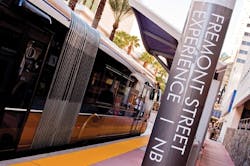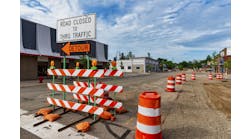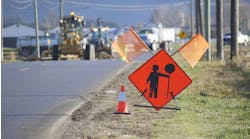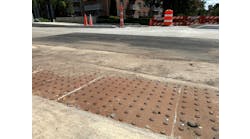Roads across the country have been built to get drivers to their destinations as quickly as possible. Accommodating automobile traffic was the No. 1 goal for road planners and traffic engineers, and Las Vegas was no exception.
As southern Nevada experienced exponential growth in the 1990s and early 2000s, neighborhoods were built seemingly overnight. Complete with cul-de-sacs and labyrinth designs, most of these new communities had only one way in and out. And the arterial roads that connected commercial centers to these housing communities were built wide—with six or more lanes of traffic—to allow for the growing influx of cars to move swiftly between home and work and back again. Brand new roads, usually with speed limits of 45 mph, stretched across the Las Vegas valley.
During the height of the housing boom in Las Vegas, it seemed as if road crews could not lay the asphalt fast enough to keep up with the expansion. Road construction seemed to be going on all the time in order to keep up with the growing population and resulting traffic demands.
Pedestrians, bicyclists and transit vehicles were relatively rare sights on the suburban roadways of the nation’s boomtown.
All aboard
Yet, this rapid growth has tempered in the last few years. The population has leveled, and the focus has turned to offering residents a more complete approach to street design. While managing the necessary arterials and freeways built over the past two decades to shuttle cars from point A to point B, the Regional Transportation Commission of Southern Nevada (RTC) has been working over the last decade to provide “complete streets” that better meet the needs of everyone who uses the street: bicyclists, pedestrians and transit riders, as well as motorists.
Complete streets can benefit everyone by increasing a road’s capacity, improving safety, stimulating economic growth, lowering emissions and promoting smarter growth. In addition, complete-street planning can help save people money as expensive car travel can be replaced with cheaper options like walking, cycling and taking public transit.
Projects undertaken by the RTC in the last few years seek to create more complete streets in southern Nevada by retrofitting the area’s wide roads with a complete-street design that accommodates public transit access, bike lanes, wider sidewalks and appropriate speed limits.
As the transit authority, transportation planning agency and regional traffic-management agency for southern Nevada, the RTC’s transportation projects are collaborative efforts. The agency works with all of the local jurisdictions, including city of Las Vegas, city of Henderson, city of North Las Vegas, Mesquite, Boulder City, Clark County and the Clark County School District as well as the Nevada Department of Transportation, to determine how best to implement a complete-streets project. The RTC works with the appropriate entities to identify what design changes would work best in each corridor. In this way, the RTC is pursuing a complete-streets model that best meets the needs of each individual community and its traffic patterns.
Rapid transit development
Since launching its first demonstration project in 2004, the RTC has continued to focus on investing in transit-intensive corridors with new bus rapid transit services that run in a dedicated right-of-way. Thanks to federal funds, including those from the American Recovery and Reinvestment Act, the RTC has built and launched four more bus rapid transit projects. In addition, the RTC also has created two express transit routes, which do not run in dedicated transit lanes but do utilize the high-occupancy vehicle (HOV) lanes on U.S. 95 and offer limited-stop service.
Enhancing work force mobility is a goal of the RTC. The new rapid transit services are offering easy, comfortable and faster transit options for workers in the Las Vegas valley. More and more commuters are leaving their cars behind at local park-and-rides and taking transit to and from work because it is a more convenient and viable option.
The RTC’s bus rapid transit routes and express services offer a more sustainable transportation option to single-passenger automobiles and have been built with a complete-streets vision in mind.
For example, the Boulder Highway Express, which launched in September 2011, runs in dedicated curbside transit lanes that were built along much of the route located on the east side of town. In addition, the construction of the Boulder Highway Express has enhanced the busy corridor by adding bike lanes, refurbishing sidewalks, adding median landscaping and installing attractive new transit stops. These improvements not only have beautified the commercial corridor, but also enable it to more safely accommodate all forms of traffic, not just cars.
In May 2012, the RTC introduced the Sahara Express, which joined the growing network of bus rapid transit and express services in the Las Vegas valley. The Sahara Express services a major east-west corridor and runs in a dedicated curbside bus lane along much of the route. The new service significantly speeds up the commute time on heavily traveled Sahara Avenue by as much as 30%. As part of this project, the RTC revamped Sahara Avenue to meet a complete-street plan, which included installing new landscaping and solar-powered transit shelters as well as widening the sidewalks to improve pedestrian safety. Traffic-signal upgrades also have been made to improve travel for all users, including pedestrians, cars and transit riders.
Cycling-friendly community
While the RTC transports more than 55 million passengers on its transit service every year, it also carries more than 50,000 bikes each month—more than the city of Portland, Ore. Thanks to the temperate weather much of the year in Las Vegas, and with the RTC’s efforts to make local roadways more bike friendly, cycling has become a popular activity, as well as a viable mode of transportation.
To ensure the streets of southern Nevada can serve both drivers and cyclists, the RTC has worked to designate more than 65 miles of bicycle routes, 280 miles of bicycle lanes and 180 miles of bicycle paths throughout the Las Vegas valley. In addition, in 2012 the RTC is working closely with other jurisdictions to bridge the gaps in bike trails and lanes throughout southern Nevada. Between 2012 and 2013, it plans to construct an additional 100 miles of bike lanes and 30 miles of bike routes.
As part of its complete-streets vision, the RTC is partnering with the city of Las Vegas to implement the valley’s first green bike lanes throughout downtown Las Vegas. The green-colored lane treatment helps to draw more attention to the bike lanes, making drivers more aware that cyclists may be present. Not only will green bike lanes help make it safer for cyclists, but they also will help elevate bicycling as a viable transportation mode. As part of this project, the RTC will widen sidewalks downtown, add more lighting and landscaping and install new intersection treatments that are intended to calm traffic and make intersections safer for both cyclists and pedestrians.
With the green bike lanes and the redesign of downtown streets in general, it has never been easier for cyclists to get around downtown. In fact, it is often faster and easier to hop on a bike and pedal to a meeting than to drive a car the short distance and look for parking.
Changing needs
The RTC continues to partner with industry experts, all of the local jurisdictions, the Nevada Department of Transportation and other interested agencies, such as the Clark County School District and the Southern Nevada Health District, to conduct a complete-streets study that provides guidance for incorporating complete-street concepts into standard planning, design and engineering practices in the region. The report will offer the RTC and its member jurisdictions design guidance and an implementation strategy for more complete streets in the Las Vegas valley, including potential action items and a suggested program for funding projects.
As a nation, our transportation needs are changing. It has been reported that today, 55% of Americans would rather drive less and walk more. Transit use is growing faster than population or highway travel rates. And two-thirds of Americans want more transportation options so they have the freedom to choose how to get where they need to go. Yet, 73% currently feel they have no choice but to drive as much as they do. The RTC sees all of these trends in southern Nevada as well.
As communities continue to evolve, the RTC is working collaboratively with local leaders and jurisdictions to build a transportation system that meets these changing needs and ensures that all of the people using our roads—drivers, cyclists, transit riders and pedestrians—can do so safely and conveniently. By promoting complete streets in southern Nevada, the RTC seeks to create more transportation choices, shorten travel times and encourage less carbon-intensive transportation, all of which will benefit everyone, now and in the future.



